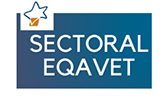EQAVET is the European reference framework for quality assurance in vocational education and training (VET). The 2020 3-years Erasmus+ project “Sectoral EQAVET for design and delivery of VET '' approaches quality of VET from a sector's point of view. The partnership of the project consists of Dimitra (Greece), Effebi (Italy), FACO (Denmark), Folkuniversitetet (Sweden and coordinator of the project), BenPO (Netherlands) and Revalento (Netherlands). The project gives substance to three out of ten EQAVET quality indicators and focuses on the improvement of matches between labour demands and VET supply in terms of quantity, quality and adaptivity.
- Indicator 5. Placement rate after VET completion, destination and employment of VET completers. (matching volume of demand and supply)
- Indicator 6. Utilisation of acquired skills at the workplace: type of occupations obtained by graduates and satisfaction of individuals and their employers with competencies acquired. (matching content of demand and supply)
- Indicator 9. Mechanisms to identify training needs in the labour market: Information on mechanisms set up to identify changing demands at different levels and evidence of their effectiveness. (adaptivity to change in demand and supply)
In the first result of the project, partners have conducted an analysis to gather a collection of “good practices” on definition of content and design of a curriculum, and in the measurement of its relevance (outcome 5 and 6 perspective).
An important conclusion from the first phase is that there is not just one strategy to narrow the gap between labour market and VET but there are at least three different ones. One approach is to try and update the curriculum and to incorporate relevant innovations and development. Being up-to-date becomes a quality indicator for VET. Another approach is to close the gap AFTER leaving VET. VET becomes the provider of training for general skills and competences required to function in certain work environments. VET becomes a provider of labour force who are in general prepared to enter a sector, but sector specific knowledge and skills are trained while already working. A third approach is somewhere in between these two.
All three approaches require a form of responsiveness which can be enhanced mutual involvement, collaboration and commitment. The good practices collected during the first results can be found on the project’s website and provide examples of practical ways which can be inspiring for improvements in various areas, independent of the strategy chosen.

